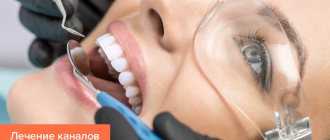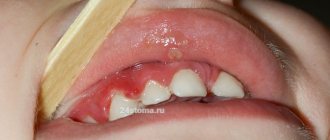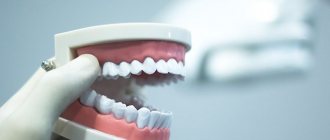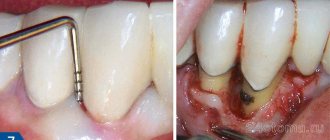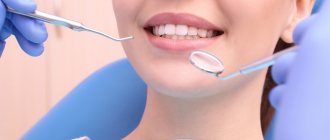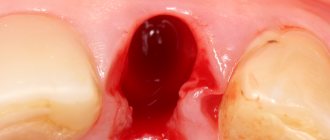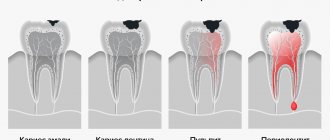Treatment of gums in children is a common reason for visiting a dentist. The susceptibility of delicate gums to inflammatory processes is explained by their sensitivity to all kinds of damage and poor hygiene. The remaining soft plaque on the teeth eventually turns into hard deposits in the form of tartar. Inflammation can also be caused by an infection that enters the oral cavity through dirty toys, for example. Unfortunately, parents are not always able to monitor the regularity and quality of brushing their children’s teeth or protect them from licking dirty surfaces.
Inflammation of the mucous membrane of the gums or gingivitis must be detected as early as possible and treatment begun. This is why regular scheduled examinations are so important. A delay in making a visit can result in a complication - there is a risk of transition to a chronic form, after which - to the ulcerative-necrotic stage, and, as a result, damage to surrounding tissues. Periodontitis is one of the most serious stages of gum disease.
Teething in infants is not only a painful process, but also provokes inflammation of the gums, as well as injuries, as a result of diligently sucking a rattle or a cracker offered by the mother...
Causes of gum inflammation in children
- Skipping or poor quality teeth brushing;
- Sucking dirty objects;
- Errors when installing seals;
- Pathologies of the dentition;
- Carious cavities with sharp edges;
- Bite correction;
- Breathing through the mouth;
- Abnormal structure of the oral cavity organs (attachment of the frenulum of the tongue and lips);
- Problems with the functioning of the cardiovascular system;
- Disruption of the gastrointestinal tract;
- Infectious diseases (ARVI, influenza);
- Hormonal abnormalities;
- Hereditary anomalies.
Causes of childhood gingivitis
This disease is quite common in children, including preschoolers and children of primary school age. Dentists call the main causes of gingivitis:
- accumulation of plaque on teeth (bacteria multiplication is observed when plaque is 1-5 days old);
- inadequate load on teeth and gums - reduced or, on the contrary, increased. This is typical for malocclusion pathology, uneven tooth growth, and crowding;
- mechanical trauma to the gum mucosa, including improper brushing of teeth, use of a brush with hard bristles, inept handling of dental floss;
- a general decrease in the child’s immunity due to acute respiratory viral infections, influenza, hypovitaminosis, and stress.
Gingivitis often occurs in combination with stomatitis, which increases pain and complicates the treatment of the disease.
Types of inflammatory processes
Gingivitis
Inflammation of the gums at the initial stage, that is, not yet spreading to the bone tissue, is called gingivitis.
Treatment of gingivitis in children follows the same principle as in adults, with the only difference being that children are prescribed more gentle medications. When starting the procedure, the hygienist performs professional cleaning, removing plaque and stone, after which he teaches the little patient proper hygiene techniques. Helps you navigate the selection of toothpaste and brush.
Periodontitis
Inflammation of the gums and periodontal tissues - periodontitis - is an advanced stage of gum disease. If left untreated, its progression may result in one or more teeth having to be removed.
Treatment includes occupational hygiene and physical therapy. If the process is advanced, surgical intervention may be required.
Periodontal disease in children
The defeat of all periodontal tissues, in this case, is called childhood periodontal disease. This degree is quite rare. Progression can be triggered by weakened immunity and vitamin deficiency.
An effective option in this case is surgical intervention, as well as strengthening the general condition of the body.
Stomatitis in children
Infectious inflammation of the mucous membrane of the gums, or stomatitis, is characterized by increased sensitivity and discomfort while eating. Therefore, you should show it to a dentist as soon as possible. A dental clinic specialist will examine the baby and prescribe appropriate procedures.
Symptoms
Signs of herpes gingivitis in a child do not appear immediately after infection. Its latent period lasts up to eight days. The disease begins abruptly. At first, the baby becomes capricious, lethargic and restless. He sleeps poorly, refuses to eat, and complains of pain in his mouth.
After some time, the following manifestations of the disease appear:
- high temperature up to 39 degrees;
- increased salivation;
- gums become swollen and red;
- intergingival papillae increase;
- the oral mucosa is swollen;
- the tongue swells and becomes covered with a white coating;
- blistering rashes on the mucous membranes and skin around the mouth;
- nearby lymph nodes enlarge;
- headache;
- bad breath;
- general malaise;
- burning.
In place of the blisters, when they burst, ulcers appear that do not heal for a long time. All other manifestations disappear within a week, but they persist for up to fourteen days.
Gum atrophy
A rather unique and rare disease - gum atrophy or exposing atrophic gingivitis manifests itself as itching in the area of 2, less often 4 and 6 symmetrically located milk teeth. A child experiencing discomfort constantly rubs the area of inflammation. At night, the itching usually intensifies.
The interdental papillae and other areas of the gums do not change in any way during gingival atrophy. Slight deposits of tartar are often observed on the unprotected root surface.
The manifestation of itching can be a consequence of measles or influenza, despite the fact that in most young patients such a relationship is not observed. The process of teething is also one of the factors causing itching in infants.
Contrary to popular belief, the main dental problems in children are not related to the teeth, but to the gums. It is not surprising, because a child’s temporary baby teeth completely change over the years, but the gums remain with the person forever. One of the most common gum diseases is gingivitis - inflammatory damage to the mucous membranes of the gums.
The damage and changes in oral tissues caused by gingivitis are not irreversible. The main thing for the child’s parents is to identify the presence of a problem in a timely manner and in no case allow the course of the disease to take its course, or miss the time to start treatment.
A distinctive feature of gingivitis is that inflammation in this disease does not affect the tissue of the tooth itself, the periosteum, or the connection between the gum and tooth.
Causes
The main cause of childhood gingivitis is almost always an insufficient level of hygiene and prevention of oral diseases.
The main cause of gingivitis in children is insufficient attention to oral hygiene.
Parents often make the mistake of teaching young children to brush their teeth, but not supervising this process in the future. A child, not understanding the importance of oral hygiene, can turn the process of brushing teeth into a fun but useless game. The result in the form of plaque is usually visible, or rather, on the teeth and gums.
Plaque on children's teeth serves as an excellent food source for microorganisms, including pathogens. As the colony of microbes grows, it causes a response from the body—inflammation occurs.
Inflammation is a visible manifestation of the body's protective immune mechanisms in response to the harmful effects of environmental factors.
Although inflammation is a natural reaction of the body struggling with an undesirable effect, this fight does not pass without a trace - the body consumes internal resources, as a result of which the inflamed tissue is gradually destroyed.
The following factors also contribute to gingivitis in children:
- unbalanced diet, lack of important minerals and vitamins, especially vitamin C;
- injuries to the mucous membrane of the gums due to malocclusion, chewing hard food, burns from hot food or drink;
- viral infections;
- diabetes;
- hereditary predisposition.
Peculiarities
Gingivitis is extremely common in childhood and adolescence, as children are most susceptible to gingivitis. This is due to the increased susceptibility of periodontal disease in children.
The periodontium is a “structure” of various tissues that holds the tooth and also supplies it with necessary substances through an extensive network of blood vessels.
The incidence of gingivitis reaches its peak with the onset of middle school age, when the accelerated growth of periodontal tissue is superimposed on the “hormonal explosion” characteristic of adolescents.
Gingivitis is not uncommon in very young children, 1 year of age or younger. This is understandable, because one of the main factors in the occurrence of gingivitis is gum trauma, which is what happens during teething. And to these natural injuries is added the underdevelopment of the immune system and the weak saturation of the oral cavity of a small child with beneficial microflora.
Sometimes you can find gingivitis even in infants. Parents are advised to immediately contact a pediatric dentist if they detect any suspicious symptoms at such a tender age.
An additional risk factor may be a short frenulum of the lip, which interferes with proper gum hygiene and contributes to the accumulation of food debris. In most cases, the labial frenulum stretches on its own, but if this does not happen before the child is 2 years old, surgical resection is performed as prescribed by the doctor.
Symptoms and classification
In order to prevent the disease from developing and begin treatment as soon as possible, you need to correctly and timely recognize the symptoms of the disease. The symptoms of gingivitis directly depend on the stage in which the disease is located.
- Catarrhal is the mildest and most common type of disease. This acute stage is characterized by redness and swelling of the gum edges, itching, burning, and the formation of characteristic dental deposits. An unpleasant odor from the mouth is noticeable. An older child may complain of an unpleasant taste in the mouth. The famous pediatrician Evgeniy Komarovsky claims that catarrhal gingivitis and stomatitis in children often accompany diseases caused by herpetic and viral infections.
- Simple marginal is a chronic, sluggish type of catarrhal gingivitis. The symptoms are similar, but less pronounced. Noticeable pain with this variety is rare, and the itching can be quite severe, which is why this disease often goes unnoticed in young children - it is simply confused with natural itching during teething.
- Desquamative is manifested by profuse redness and peeling of the gum mucosa.
- Hyperplastic most often occurs with hormonal origins of the disease, which is typical for adolescents. This type of disease is distinguished by noticeable inflammation of the protrusions of the gums between the teeth - the so-called periodontal papillae. When swollen, the papillae form sinuses at the base of the tooth, which are often filled with foul-smelling pus. The gums bleed.
- Hypertrophic is a severe chronic form of hyperplastic gingivitis. The swelling of the inflamed periodontal papillae in this form of the disease is so pronounced that the crown of the tooth can be significantly (sometimes completely) hidden in the swollen gum.
- Ulcerative necrotic is a severe form of the disease. The child experiences severe burning pain, open bleeding ulcers form at the base of the teeth, and the bases of the teeth are partially exposed. Signs of general malaise may appear - weakness, nausea, fever.
- Atrophic - the most severe stage of inflammation of the mucous membrane of the gums, the gum tissue becomes noticeably thinner, and the bases of the teeth are greatly exposed. Bleeding and discharge of pus are profuse, severe pain requires medication relief.
If left untreated, childhood gingivitis progresses to the stage of deep periodontal damage - periodontal disease, which is fraught with the loss of a significant part of the dentition.
Treatment of gingivitis in children
Treatment in the early stages
Gingivitis in the early, not advanced stages (catarrhal and simple marginal gingivitis) can be easily treated on your own at home.
You should start by alleviating the child’s condition. Anesthetics, in particular various lidocaine-based drugs, will help relieve pain. For the treatment of children, it is recommended to use the lidocaine-containing drug “Kalgel”. This gel-like product is approved for use even for the youngest patients, even with gingivitis in a one-year-old child. "Kalgel" can be used, among other things, for teething in infants.
The use of bactericidal ointments and rinses, such as:
- Propsol;
- Eludril;
- Chlorhexidine;
- Romazulan.
Also, one of the most commonly used medications for gingivitis in a child is Cholisal gel. This drug, in addition to being anti-inflammatory, also has a bactericidal effect. In any case, before using vitamin supplements and medications, especially when treating gingivitis in infants, it is better to consult with your doctor.
It is also important to pay attention to the nutrition of children: food for gingivitis should not be too cold or hot, sour or salty. The main task during this period is to minimize the impact of irritating factors on the oral cavity.
After relieving inflammation and reducing pain, therapy is carried out aimed at destroying pathogens. For this purpose, antibiotic drugs are widely used, for example, Amoxicillin, Metronidzole, Erythromycin.
After the use of antibiotic drugs, restorative therapy necessarily includes a course of probiotic drugs that help restore the normal bacterial background and replenish beneficial microflora.
Treatment of hyperplastic and hypertrophic forms
Severe forms of gingivitis can only be treated in specialized medical institutions. Treatment of hyperplastic gingivitis and its severe form, hypertrophic gingivitis, in addition to an anti-inflammatory course and antibacterial measures, may include removal of swollen gum tissue. The following methods are used for this:
- Freezing . Sclerosing agents are injected into the gum tissue: dextrose solution or calcium chloride. The introduction of these drugs causes hardening of the periodontal papillae and the cessation of pathological tissue growth.
- Cauterization with electric current . It allows you not only to stop the growth of edema in a large area of tissue, but also to stop bleeding. Cauterization is carried out using the method of diathermocoagulation - exposing the tissue to a current of 3-5 Amps of high frequency. The procedure is painful and is performed under local anesthesia, so it is not recommended for children under five years of age.
- Chemical cauterization . A mixture of sulfuric acid solution and ether is applied to the dried surface of the gum with a cotton swab.
- Gum trimming (gingivectomy). It is used in especially severe cases, when healing a child’s oral cavity without surgery is no longer possible. The operation is performed under general anesthesia and, as a rule, occurs without complications. Gingivectomy must be combined with freezing or cauterization of the gums, otherwise the pathological growth may continue, and after some time the truncation will have to be performed again.
Treatment of ulcerative necrotic and atrophic gingivitis
The sooner a child suffering from ulcerative or atrophic gingivitis gets to a dentist, the better. At home, the child should be given bed rest and rest, as general malaise may be observed, accompanied by an increase in temperature.
In case of pronounced bleeding of the gums, when gingivitis has reached the ulcerative or atrophic stage, it is not recommended to use toothbrushes with hard bristles. In severe cases, you will have to refrain from brushing your teeth altogether, limiting yourself to rinsing your teeth with special balms.
Antiviral and anti-inflammatory therapy for these forms is similar to similar procedures for marginal and catarrhal gingivitis. Bleeding is stopped with the help of spot application (application) of hydrogen peroxide.
Necrotic (dead) tissue areas around ulcers are removed surgically or conservatively using the method of necrolysis - non-surgical resorption. Necrolysis of dead tissue is carried out by applying the sublimated enzyme trypsin dissolved in sodium chloride to the affected areas.
After the inflammation has stopped and the ulcers have healed, the child may need gingivoplasty - restoration of lost areas of gum by transferring tissue flaps from other areas of the periodontium.
Folk remedies
A serious help in the treatment of gingivitis will be turning to traditional medicine and homeopathy. To prevent oral diseases and strengthen teeth, decoctions of oak bark, sage, St. John's wort, and motherwort have long been used.
To treat inflammatory processes in a child, the use of alcohol-based infusions, as well as an alcohol solution of iodine, is not allowed!
Traditional recipes:
- St. John's wort oil. The product is prepared independently from dry leaves of St. John's wort, which can be purchased at the pharmacy. A tablespoon of crushed leaves is poured with half a glass of refined vegetable oil and left to infuse overnight. Lubricate inflamed gums with St. John's wort oil three times a day.
- A mixture of sage and eucalyptus leaves in equal proportions is poured with boiling water at the rate of a teaspoon of sage and eucalyptus per glass of boiling water. Leave for 24 hours and strain. Take a tablespoon before meals.
- Dilute 3-4 grams of mumiyo in a glass of warm water and use it to rinse your mouth before bed.
- Another way to use mumiyo: dilute the same amount (3-4 grams) in a glass of warm low-fat kefir (mix thoroughly!). Keep in mouth for two to three minutes, then swallow.
Prevention
The main means of preventing gingivitis, as well as other dental diseases, is oral hygiene. From a very early age, teach your child to brush their teeth for at least 10-15 minutes, making sure to pay attention to the inside of the teeth. Buy your child a therapeutic toothpaste and make sure he brushes his teeth correctly. To eliminate stubborn plaque, you can use a brush with moderately hard bristles. After brushing, teeth should be rinsed thoroughly.
Teach your child to use dental floss to remove food debris from between the teeth. But keep in mind that dental floss can also injure the gums if used incorrectly, so it is not recommended to use dental floss for a child under 3 years of age.
Modern dentistry does not encourage the use of toothpicks for dental care, since their use risks not only injuring the gums, but also causing infection. Give preference to dental floss.
If tartar has formed in your child’s mouth, then a visit to the dentist is essential. The doctor will remove tartar in the most gentle way possible.
Diagnosis of gum disease in children
A routine oral examination should be performed by a pediatric dentist every six months. And as necessary, if a small patient exhibits any deviations in the development of teeth or symptoms of disease of the oral mucosa. Since it is advisable to diagnose the inflammatory process at the earliest stage.
If redness, swelling and bleeding are detected, the cause of which is an excessive amount of soft plaque or food debris on the teeth, the dentist will make a diagnosis and prescribe procedures.
If a bacterial infection is suspected, a clinic specialist can take biomaterial from the inflamed areas of the gums for clinical tests. Based on the results of the analysis, the specialist prescribes a treatment plan and the date of the next appointment to ensure the final recovery of the little patient.
Diagnostics: how to find out that a child has gingivitis
The doctor makes a diagnosis based on an examination of the oral cavity, complaints from the patient (or his parents), as well as functional tests performed to determine the amount of microbial plaque and the bleeding index.
To avoid errors in diagnosis, the doctor prescribes an X-ray examination of the teeth. The main difference between gingivitis and other diseases is that the inflammatory process affects only the gums. Bone tissue and muscle ligaments remain unchanged.
Author: Maria Kozodoeva Dentist-therapist, periodontist. Work experience more than 11 years.
The information is for reference only. Before treatment, consultation with a doctor is necessary.
Treatment of gums in children
Medicines prescribed by a doctor have analgesic, antibacterial and anti-inflammatory effects. They help restore the proper condition of the mucous membrane. Methods of using drugs are different, but the principle is the same: rinsing, irrigation.
For gum disease in infants, the dentist will prescribe special gels to relieve symptoms, namely itching and pain. Parents should pay special attention to cleaning their mouths from food debris.
Antibiotics are prescribed by a dentist in rare cases. Indications for the use of antibiotics is a form that reaches a complex (ulcerative-necrotizing gingivitis) or chronic stage. Antibacterial or antifungal drugs are prescribed when the problem is caused by an infectious process, and the goal is to eliminate its causative agent.
Preventive actions
The best prevention of inflammation of the mucous membrane is daily and high-quality hygiene from an early age and proper nutrition.
Hygiene
The concept of “quality hygiene” includes brushing your teeth at least twice: in the morning and in the evening, in conjunction with cleaning the palate and tongue.
Parents should take a very responsible approach to hygiene from the day the first tooth appears. And after he grows up a little, learn the rules of brushing his teeth: regularly and efficiently. The toothbrush and toothpaste should be selected according to the age of the small patient.
Nutrition
In addition to hygiene, parents need to approach the diet wisely: it should be balanced and include vitamins and minerals. Sweets and carbonated drinks should be consumed by the child in limited quantities. In addition, after finishing eating sweets, the baby should rinse his mouth with water and, if possible, brush his teeth. Note that a diet that promotes the proper development of a growing body includes nutritious and timely meals. Snacking and disordered eating should be kept to a minimum.
What is pathology
Gingivitis is an inflammatory pathology of the gums, in which there is no damage to the periodontal junction or other periodontal tissues (tissue surrounding the tooth). If treatment does not occur for a long time, then damage to these structures, called periodontitis, may occur. Most often in children, the marginal part of the gum, located next to the dental neck, is affected.
The inflammatory process is promoted by:
- high activity of biological processes in gum tissue;
- formation of the dental system;
- unformed local immunity.
Most often, gingivitis is detected in a child aged 2–4 years, as well as in one-year-old babies during teething.
Treatment of children at RAIDEN
In the RAIDEN network of dental clinics, the treatment and prevention of oral diseases of young patients is treated with the utmost attention and reverence - the health of the younger generation is very important to us!
All medications used in our clinic meet the highest quality requirements. Before using them, we conduct a blood test of the baby to determine drug tolerance. The safety of your children, our little patients, is paramount to us.
Complications and consequences
If the above symptoms occur, you should immediately visit your dentist. Treating the disease at home can significantly aggravate the situation and also lead to irreversible consequences. Only a doctor can correctly diagnose the disease, prescribe effective treatment and prevent complications.
In case of delayed or self-selected treatment, which turned out to be ineffective, gingivitis can cause periodontitis, mobility and tooth loss. Children may complain of pain from contact with any food, be capricious and refuse to eat and drink.
